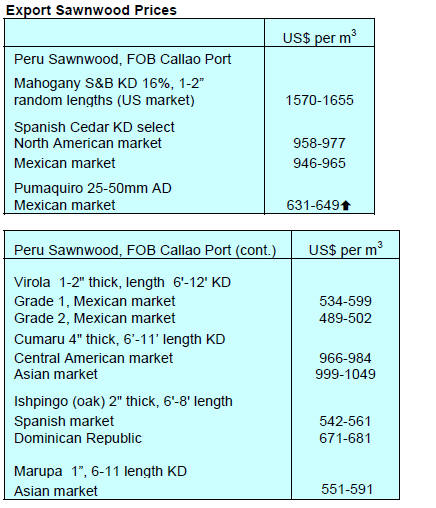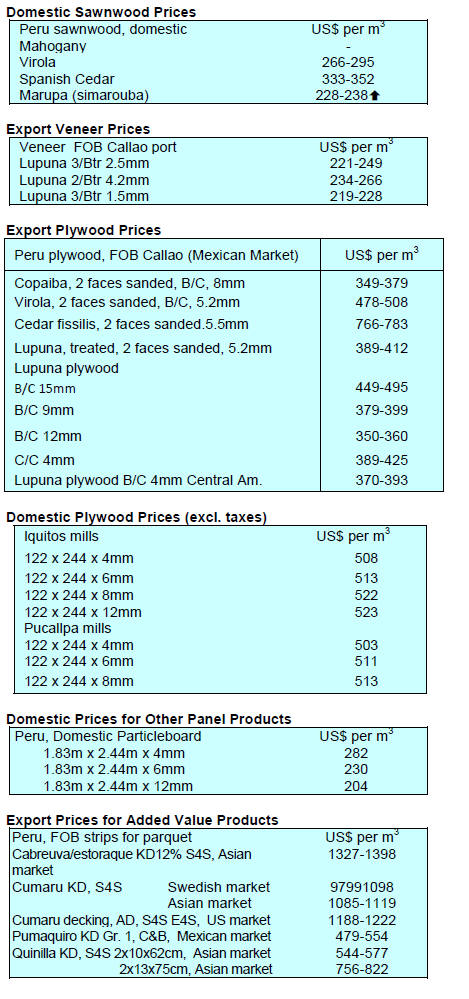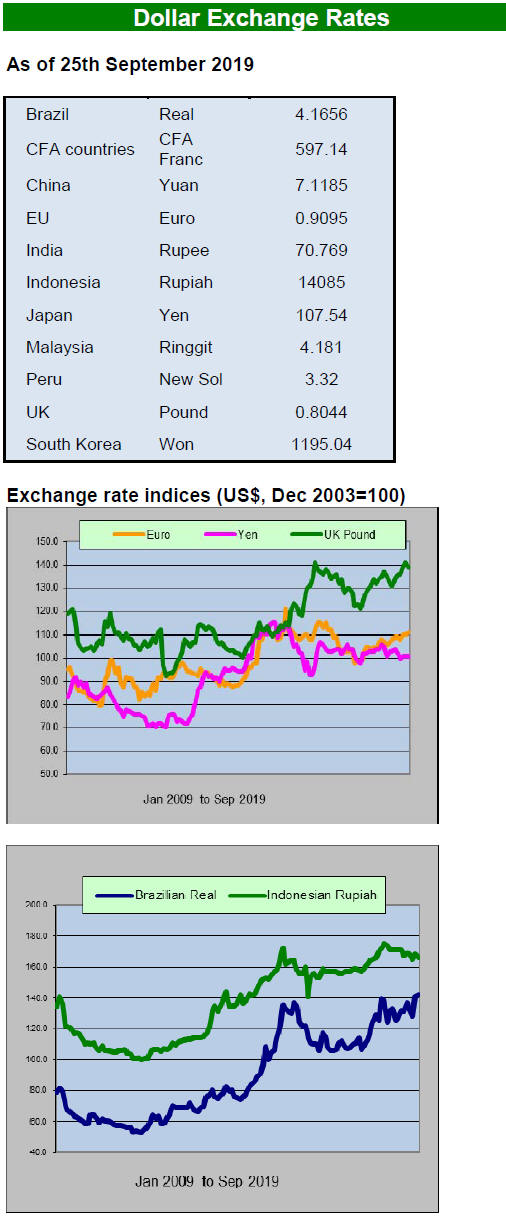3.
MALAYSIA
MTCC sets new goals
The Malaysian Timber Certification Council (MTCC)
recently celebrated its 20th anniversary. Since the
establishment of MTCC in October 1998, much has been
done to implement the Malaysian Timber Certification
Scheme (MTCS) with priorities given to planning,
creating awareness, building trust and confidence among
the various stakeholders as well as gaining international
recognition for the scheme.
As of March 2019 a total of 22 forest management units
(FMUs) have been certified under the MTCS. Of these, 15
FMUs are for natural forests covering around 4.5 million
ha. the remaining seven FMUs are forest plantations
extending over almost 121,000 ha. Additionally, a total of
364 timber companies have been certified under the
MTCC’s chain of custody scheme.
With its successes to date the MTCC has reviewed the
progress and set a path up to 2025 with seven major goals
outlined in a publication /MTCC Strategy 2020-2025:
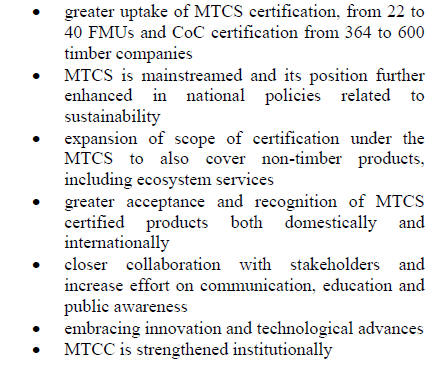
See:
http://mtcc.com.my/mtcc-20th-anniversary-conference/
Trade conflict to expand immediate
opportunities and
create long lasting market ties
Former Malaysian Furniture Council President, Chua
Chun Chai, is optimistic that Malaysian furniture exports
to the US could grow substantially over the next few years
having got a boost from the high tariffs on Chinese exports
and through expanded business ties with US importers.
Chua has said Malaysian manufacturers need to recognise
that the furniture supply chain, once dominated by China,
is evolving with Vietnam, Indonesia and Malaysia vying
for a greater share of international demand.
In the first five months of 2019, Malaysian furniture
exports to the US grew year on year by almost 21% to
RM1.55 billion.
Between January and May 2019 Malaysia’s share of
the
markets was 38% in the US, around 8% in Japan and
Singapore and almost 6% in both Australia and the UK.
See: https://www.thesundaily.my/business/us-china-trade-waraugurs-
well-for-furniture-exporters-MA1121482
Sabah log ban an boon for furniture makers
Malaysia Furniture Council Vice Chairman Cha Hoo Peng
has said the log export ban in Sabah is benefitting the
downstream industry in the State, particularly the furniture
sector which has seen sales increase.
The issue now, said Cha, is that while raw materials are
adequate there is an acute shortage of skilled workers for
the furniture sector.
One country, three forest policies
Malaysia has three different forestry policies and sets of
laws one for each of Peninsular Malaysia, Sarawak and
Sabah and recently Dr. Xavier Jayakumar, the Federal
Ministry of Water, Land and Natural Resources, has
suggested there would be advantages in bringing all three
forest policies into a common Malaysian Forestry Policy.
Dr. Xavier stressed that the suggestion did not mean that
the ministry was considering amendments to any of the
current policies as he knows forest policy is a matter for
each State and the Federal government does not have any
right to demand changes. The Minister invited all
concerned parties to consider this so it can be discussed at
a later date.
Malaysian exhibitors did well at Shanghai Fair
In a press release the Secretary-General of the Ministry of
Primary Industries Dato’ Dr. Tan Yew Chong,
congratulated the Malaysian Timber Council (MTC) for its
successful Malaysia Pavilion at the 25th China
International Furniture Expo. In 2018 Malaysian furniture
manufacturers exhibiting at MTC’s pavilion recorded sales
of RM10.92 million but this year’s sales are expected to be
around RM28 million.
The MTC has been supporting participation in this fair for
the past five years and this year19 Malaysian furniture
companies exhibited and promoted sales.
The MTC has said this fair is a useful venue to boost
business as it not only attracts buyers from within China
but also other international buyers from countries such as
the United States, Canada, United Kingdom, South Africa,
Spain, Japan, France, India and Italy.
See:http://www.mtc.com.my/images/media/691/Furniture_China_Press_Release_2019_-Bernama-.pdf
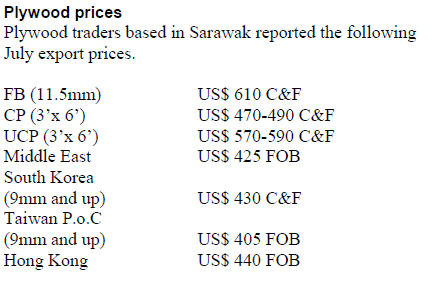
4.
INDONESIA
Major effort to capture market share in the
US
The Indonesian President recently met with timber
industry representatives to discuss how to take advantage
of the US/China trade friction specifically on how to push
Indonesian furniture exports to the US.
The government has introduced incentives such as the
value-added tax exemption for logs and a partial relaxation
of the timber legality assurance system (SVLK) for
exports to countries where SVLK certification is not
mandatory.
Indonesia’s exports of wood products were worth US$2.2
billion in the first seven months of this year down around
14% year on year. On the other hand furniture exports rose
9.4% year-on-year to US$1.12 billion in the first seven
months of this year.
The Chairman of the Association of Indonesian Forest
Concessionaires (APHI) Indroyono Soesilo, said value
added tax exemption for log (currently at 10%) is good
news for the domestic downstream wood industry.
But serious hurdles are yet to be overcome one of which is
the high cost transportation and logistics according to the
Director General of Small, Medium and Miscellaneous
Industries of the Ministry of Industry, Gati
Wibawaningsih. She pointed out that compared to China
and Vietnam. Indonesian exporters face very high logistic
costs which undermines competitiveness.
Proposed simplification of the mandatory SVLK
Companies are eager to hear how the SVLK has been
simplified. Gunawan Salim, International Relations and
Marketing Manager of Indonesian Wood Panel
Association (Apkindo), said a simplification would help
small companies become more competitive in markets
where SVLK is not mandatory.
See:
https://ekonomi.bisnis.com/read/20190912/99/1147485/pebisniskayu-nantikan-penyederhanaan-mandatori-svlk#
Not everyone is keen on a simplification of the
SVLK
however’ Asmindo (Indonesian Furniture and Handicraft
Industry Association) Executive Director, Indrawan, said
that there must be consistency in implementing the SVLK
to ensure good forest governance.
According to Indrawan, every business in the timber sector
should have a business license and a business permit as
required by the SVLK. However, he did point out that for
small and medium businesses need help in meeting the
requirements of the SVLK.
Also adding a word of caution, Dwi Sudharto, Head of the
Center for Research and Development of Forest Products
at the Ministry of Environment and Forestry (KLHK), said
the SVLK has eliminated the negative image of Indonesia
timber sector and that lowering the SVLK standard is
being promoted by businesses that do not want to follow
the regulations.
See:
https://news.trubus.id/baca/31778/jpik-nilai-revisi-svlkhancurkan-reformasi-tata-niaga-kayu
SMEs targeted for assistance on SVLK
The Ministry of Environment and Forestry (KLHK) is
targeting 400 groups of micro, small and medium
enterprise groups for assistance in satisfying the national
Timber Legality Verification System (SVLK).
The Director of Processing and Marketing of Forest
Products in the KLHK more SMEs will be assisted this
year. In 2018, 152 groups of SMEs comprising 3,172
industrial SMEs and 247 private forest owners. This year
the KLHK will spend Rp20 billion from the state budget
for this exercise.
Prices for domestic logs being undermined by weak
international demand
Weakening international demand for processed wood
products is beginning to impact the domestic market for
logs. Purwadi Soeprihanto, Executive Director of the
Asssociation of Indonesian Forest Concessionaires,
(APHI) has reported that in the first seven months of 2019
log sales were 25.2 million cubic metres compared to the
26.1 million cubic metres in the same period 2018.
The decline is the result of sluggish international demand
largely the result of the escalation of the trade
frictionbetween the United States and China. The
immediate impact of softening demand has been a fall in
plywood prices which feeds back into the prices offered
for domestic logs.
Purwadi indicated there are about 14 million cubic metres
of raw material available but if prices fall owners will
reduce harvests.
See:
https://ekonomi.bisnis.com/read/20190919/99/1150184/produksikayu-bulat-tergerus-lemahnya-permintaan
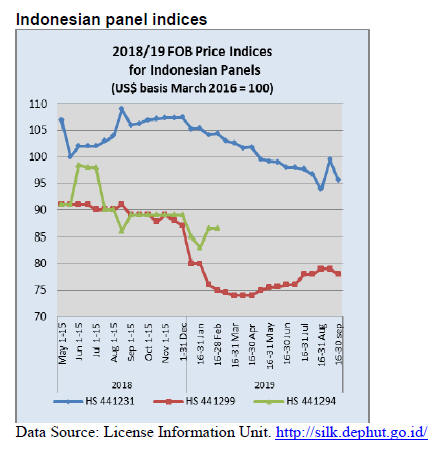
5.
MYANMAR
First timber legality certificate issued
The Myanmar Forest Certification Committee (MFCC)
has announced that the first MTLAS Legality Certificate
has been issued providing details on the shipper, the type
of products and species among other details.
See:
http://www.myanmarforestcertification.org/certificates/
Barber Cho, Secretary of MFCC, said getting to this
point
was the result of two-years of hardwork. Cho continued
saying that the MFCC has built a reliable MTLAS with
limited resources.
Over the past two years the Certification Committee and
supporters compiled the certification standard and
provided auditors training for certification bodies.
Currently the MFCC recognises three certification bodies
and will soon announce approval of others.
The major challenge going forward is accreditation in
Myanmar. The Department of Research and Innovation
(DRI) under Ministry of Education is currently the official
Accreditation Body but the DRI is not yet a member of the
International Accreditation Forum (IAF).
The IAF is the world association of Conformity
Assessment Accreditation Bodies and other bodies
interested in conformity assessment in the fields of
management systems, products, services, personnel and
other similar programmes of conformity assessment.
Because the DRI is not accredited to IAF it has little
international standing in the accreditation of Myanmar’s
certification bodies. As an interim measure, MFCC has
assumed the role of accreditation body but it is the priority
of the MFCC to solve this accreditation issue as soon as
possible.
With the issuance of the first MTLAS legality
certificate,
Cho, on behalf of the MFCC, put on record the gratitude to
PEFC which provided assistance in the development of the
legality certification process in Myanmar. The MTLAS
process began in 2009 and the PEFC began to provide
assistance in 2017/18 for which everyone in Myanmar is
grateful.
The MTLAS is a uniquely Myanmar effort but has built
upon the experiences of other countries and the PEFC
expertise in building capacity in the MFCC, training
auditors and introducing the PEFC chain of custody
system. The MFCC looks forward to further cooperation
with the PEFC to strengthen and promote Myanmar’s
forestry and wood products sectors.
The MFCC anticipates that as soon as the accreditation
issue is resolved the MTLAS certificates will benefit
importers in the EU in meeting the due diligence
requirements of the EUTR. Cho said he is well aware that
there is much to do to overcome the concerns on
allegations of corruption in Myanmar, on improving
transparency and a host of other domestic issues of
concern to the international community.
Memorandum of understanding with RECOFTC
Myanmar's Forestry Department signed a memorandum of
understanding with RECOFTC (The Center for People and
Forests) an international not-for-profit organisation that
focuses on capacity building for community forestry in the
Asia Pacific region.
The agreement is the second between the Forestry
Department and RECOFTC. The organisations signed the
first agreement in 2013. Since the beginning of the
partnership, Myanmar has achieved important milestones
in forestry. The most notable being the formation of a
Community Forest National Working Group (CFNWG) in
2014 and the establishment of a community forest
database.
Maung Maung Than, Director of RECOFTC Myanmar,
said this agreement is an important milestone in the
history of community forest development in Myanmar as
it will continue to address challenges that face the
country’s forests and the communities that depend on
forests.
Work under the new agreement will focus on the
development a plan for Myanmar’s Community Forest
National Working Group. The working group aims to
establish 14,000 hectares of community forest a year. The
working group will also strengthen community forest
enterprises.
Belt and Road plan being discussed
The governments of China and Myanmar are negotiating a
five-year plan on economic and trade cooperation under
the Belt and Road Initiative.
Investment in infrastructure in Myanmar is expected to
increase over the next 18 months as a result of projects
including those under the China-Myanmar Economic
Corridor (CMEC) such as the New Yangon City,
Kyaukphyu Deep Sea Port and the Kyaukphyu-Kunming
Railway projects.
Foreign investment flows improving
Myanmar’s economy is forecast to expand 6.4% in the
current fiscal year and to 6.8% in the next according to the
Institute of Chartered Accountants in England and Wales
(ICAEW). The report said that the forecast for Myanmar’s
economy is positive as the country opens to foreign
investment. The ICAEW report mentioned that the
infrastructure, manufacturing and wholesale and retail
services sectors are expected to be the greatest
beneficiaries.
According to the Myanmar Investment Commission after a
14% decline in foreign investment to US$5.7 billion in
2018 foreign investment inflows are now rising
improving.
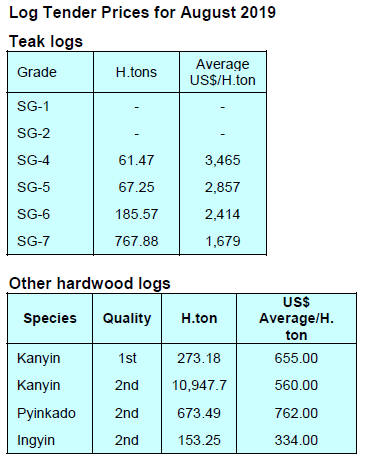
6. INDIA
Modest rise in wood product price indices
The official Wholesale Price Index for ‘All Commodities’
(Base: 2011-12=100) for August 2019 rose to 121.4 from
121.2 for the previous month. The index for the group
'Manufactures of Wood and of Products of Wood and
Cork ' declined to 134.1 from 134.2 for the previous
month due to lower price of wooden splints, sawnwood
and wooden boxes/crates. However, the price of veneer
sheets and wooden blocks moved higher.
The annual rate of inflation based on monthly WPI in
August 2019 stood at 1.08% compared to 3.27% in August
in the previous year.
The press release from the Ministry of Commerce and Industry
can be found at:
https://eaindustry.nic.in/pdf_files/cmonthly.pdf
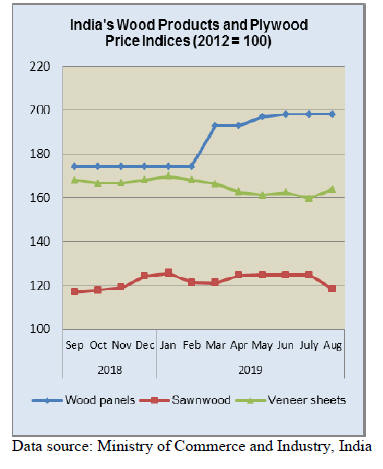
Tax cuts and boost to housing
The Indian government has reduced taxes for
manufacturers in an effort to revive the economy. It has
been reported that the Finance Minister, Nirmala
Sitharaman, announced a reduction in the country’s
corporate tax rate from around 35% to 25%. For
companies that do not benefit from any other incentive the
effective tax rate would be just 22%.
In addition she revealed that firms incorporated after
October this year will be taxed at 15% instead of 25%.
These decisions resulted in a slight strengthening of the
rupee against the US dollar. However, some analysts have
raised concern on the impact of these cuts on government
finances.
The current economic slow-down is mainly due to weak
consumer demand so analysts say there is little reason for
companies to invest even if their tax falls. Indian
consumers are not spending because of unemployment
risks and falling wages. Under these conditions expanding
investment in housing projects or manufacturing is risky.
To further boost growth prospects action is being
discussed to kick-start completion of stalled housing
projects through easier borrowing terms for affordable
home buyers.
See:
https://housing.com/news/rbi-monetary-policy-interestrates/?utm_source=internal&utm_medium=email&utm_campaign=subscribersDigest
Plantation teak imports
At the most recent meeting of the Goods and Services Tax
Committee over 100 cases were considered and most
provided with relief but the GST on wood products has not
been reduced.
The rupee rose in late September after forex trading
sentiment was boosted by the government decision to
lower corporate taxes. C&F prices for imported plantation
teak products remain unchanged from two weeks earlier.
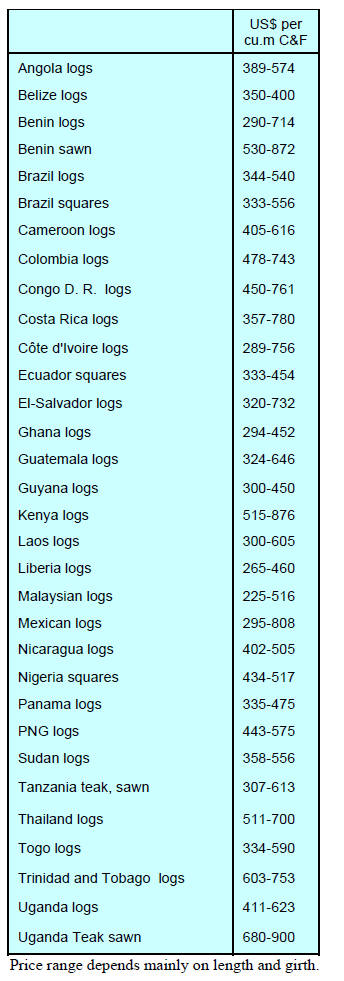
Locally sawn hardwood prices
Ex-mill prices have been maintained despite demand being
flat.
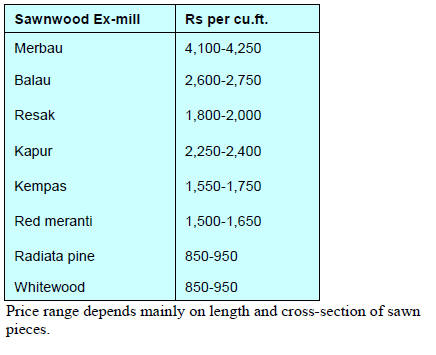
Myanmar teak prices
The timber sector has accepted that for the medium term
the GST Committee is unlikely to recommend reduced
GST for wood products. The economic stimulus from the
government may boost demand but it is not only demand
that is an issue the other concern of manufacturers is the
difficulty in securing credit.
Traders are reporting that there are signs that demand for
Myanmar teak may be firming but this has not yet
translated into an opportunity to raise prices.
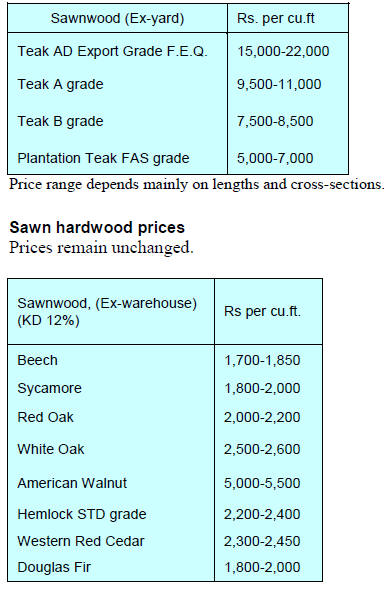
Price range depends mainly on lengths and
cross-sections.
Plywood
Plywood manufacturers continue to face problems related
to the rising cost of log raw materials and other inputs. It
has been learnt that the main plywood associations have
been discussing when the next round of prices increases
should be introduced.
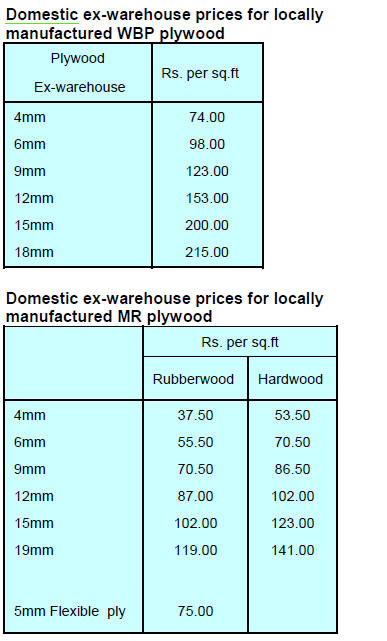
7.
VIETNAM
Vietnam’s wood products trade
According to the General Department of Customs,
Vietnam’s exports of wood (especially chips) and wood
products in August 2019 continued to rise reaching
US$935 million, up 8.2% compared to July 2019.
Exports of manufactured wood products totalled US$671
million in August an almost 6% increase from July.
Cumulative export earnings for the first 8 months of 2019
totalled around US$6,613 billion, a 17% rise year on year.
The major export markets were the USA, Japan, China,
South Korea and UK. The top 5 markets accounted for
around 85% of total exports.
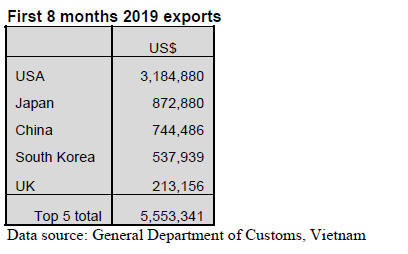
Turning to wood and wood product imports,
the General
Department of Customs reports that imports in August
2019 dropped for the second consecutive month to
US$219 million, an almost 2% fall compared to July 2019.
However, in the first 8 months of 2019 imports totalled
US$1.675 billion, up 14.4% over the same period in 2018.
The main suppliers in order of rank were China, USA,
Thailand, Chile and Brazil.
See:
http://goviet.org.vn/bai-viet/muc-tieu-xuat-khau-go-11-tiusd-nam-2019-tren-duong-ve-dich-9033
Industrial expansion driving up labour costs
Vietnam’s Foreign Investment Agency has reported that
total foreign investment has increased sharply this year
with about 60% of this investment going into the wood
processing sector.
The surge in investment has put pressure on labour supply
and Nguyen Quoc Khanh, Chairman of Ho Chi Minh City
Handicraft and Wood Processing Association (HAWA)
said the number of new factories processing wood has led
to labour shortage and is driving up labour costs. He
reported that labour costs in the industrial zones have risen
by 10-20% but enterprises are still finding it difficult to
recruit people.
Productivity in timber sector below ASEAN levels
According to the Vietnam National Economics University,
labour productivity in Vietnam’s wood processing
industry is significantly lower than in most other ASEAN
countries.
The university report says Vietnam’s labor productivity is
just 7% of that in Singapore; 18% of that in Malaysia and
55% of that in the Philippines. The report cites industrial
structure and organisational management as substantial
contributing factors.
The study identified the main problems as poor time
management, low entrepreneurship and weak corporate
management. Only through raising labour productivity
will Vietnam’s timber processors be able to maintain
competitiveness said Nguyen Ton Quyen, Secretary
General of Viforest (Vietnam Timber and Forest Product
Association).
An MOU has been agreed between three parties; the
Handicraft and Wood Industry Association of Ho Chi
Minh City (HAWA), the Taiwan (P.o.C) wood processing
Association and Ho Chi Minh Technical Education
University aimed at lifting the productivity of labour in the
wood processing sector.
All industries in Vietnam are facing fiercer competition at
home and in international markets and much of this stems
from the inflow of advanced processing and skilled
management in foreign companies that have set up
operations in Vietnam.
See:
https://baodautu.vn/hop-tac-3-ben-nang-cao-nang-suat-laodong-nganh-go-d107519.html
8. BRAZIL
Furniture production back into positive
territory
In July 2019, furniture production picked up in the two
main producing states, Rio Grande do Sul and Paraná
marking the first rise in production for the past six months.
In Rio Grande do Sul there was an almost 34% rise in
production compared to a month earlier while in Paraná
there was a 15% increase. In June this year production in
Rio Grande do Sul dropped 13% month on month and in
Paraná there was an 8% decline.
Although the July production figures in Paraná were good
they were not enough to compensate for the downturn in
the first seven months of 2019. The annualised rate of
Paraná´s furniture production remained at -4.5%.
Cumulative furniture production in Rio Grande do Sul in
the first seven months of this year rose by almost 5%
compared to a year earlier.
Brazilian Forest Service prepares for COFO
The Brazilian Forest Service (SFB) participated in the 31st
FAO Latin America and the Caribbean Forestry
Commission (LACFC) meeting held in the first week of
September, in Montevideo, Uruguay. SFB participated in
the panel discussions on Restoration of forests and
landscapes; Forest Protection: Integrated fire management,
Forest health and invasive species, Preventive approach to
illegal logging and Forests and Bio-economics.
LACFC was established in 1948 and aims to provide a
technical and political forum for member countries of
Latin America and the Caribbean to discuss forest-related
issues and their contribution to food security.This event
discussed the forest agenda of the countries of the region
and was a preparatory meeting for the FAO World
Forestry Committee (COFO) meeting to be held in Rome
in 2020.
At the meeting, the SFB Director detailed the activities of
the Brazilian Forest Service especially the Environmental
Rural Registry (CAR), forest concession control and the
work developed by the National Forest Inventory.
The Director also highlighted the importance of these
projects for the establishment of the Brazilian Forest Code,
for the promotion of sustainable use of Brazilian forests
and for planning of government policies related to the
country's forest management.
Export update
In August 2019, Brazilian exports of wood-based products
(except pulp and paper) fell 22% in value compared to
August 2018, from US$282.4 million to US$219.7
million.
The value of pine sawnwood exports declined 30%
between August 2018 (US$47.1 million) and August 2019
(US$32.8 million). In volume terms exports dropped
around 20% over the same period, from 204,800 cu.m to
164,200 cu.m.
Tropical sawnwood exports also dropped (-16%) in
volume, from 45,800 cu.m in August 2018 to 38,500 cu.m
in August 2019. The value of exports also dropped (-29%)
from US$20.2 million to US$14.4 million over the same
period.
The value of pine plywood exports fell 41% in August
2019 in comparison with August 2018, from US$64.2
million to US$37.6 million. In volume terms pine plywood
exports dropped just 9% over the same period, from
182,800 cu.m to 166,000 cu.m.
Following the same trend export volumes of tropical
plywood fell (-57%) and in value (-59%), from 12,900
cu.m (US$ 6.1 million) in August 2018 to 5,600 cu.m
(US$ 2.5 million) in August 2019.
To complete the depressing picture, wooden furniture
exports declined from US$51 million in August 2018 to
around US$45 million in August 2019, a 12.4% decline
year on year.
First half 2019 plantation sector performance
The IBÁ Bulletin from the Brazilian Tree Industry reports
a 2.9% first half 2019 increase in the value of sector
exports in comparison with the first half of 2018. In the
first six months of the year overseas trade topped US$5.6
billion. Pulp exports increased 1% in the period, while
paper exports increased by 4.1%.The trade balance for the
sector reached US$5.1 billion, a 3.3% year on year
increase.
In the first half 2019 China was the main market for
Brazilian pulp accounting for US$1.9 billion of all pulp
exports. Latin American countries were the main market
wood panels (US$ 89 million) and paper (US$ 592
million).
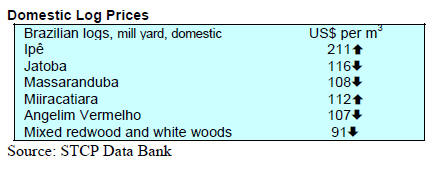
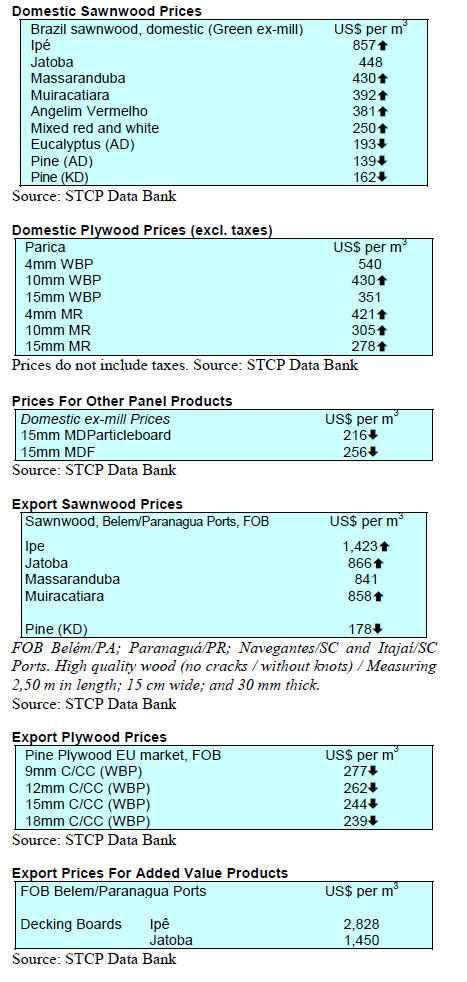
9. PERU
Budget increase for forestry authorities
Regional forestry authorities have two ways to generate
the income necessary to finance their operations: the first
is allocations from the Ministry of Economy and Finance
(MEF) and the second is through directly collected fees
and charges levied on companies.
For many years regional forestry authorities have been
pointing out that their operational budgets were
insufficient to properly supervise forest management. To
address this the regional governments of Loreto, Ucayali
and Madre de Dios determined that they should make an
effort to increase allocations from the central government.
These efforts have paid off as recently the MEF approved
the transfer of additional resources to the three regional
forestry authorities in the amount of around US$2.5
million.
This effort was possible because the regional authorities
could articulate their needs. To achieve this they had the
technical support of the USAID Forest Program and the
United States Forest Service (USFS).
Analysts write that this is the first time that a forestry
authority has requested and received an additional budget
from the Ministry of Economy and Finance.
Capacity building for forestry sector transparency
As transparency is a fundamental of governance a process
of capacity building in transparency and access to public
information in the forestry sector is being promoted.
The first step has been a workshop in Lima attended by the
National Forest and Wildlife Service (SERFOR), the
Agency for Supervision of Forest Resources and Wildlife
(OSINFOR) and the Regional Governments of Loreto and
Ucayali. Members of the Ombudsman's Office and the
Digital Government Secretariat also participated.
According to Eduardo Luna, Director General of
Transparency, Access to Public Information and
Protection of Personal Data in the Ministry of Justice, this
process which has just started could result in improved
directives, guidelines and a policy on transparency for the
forestry sector initially and then other sectors.
Trends and solutions in plantation establishment and
management
Because of the increase in forest plantations, especially in
the Amazon, the “First Peruvian Meeting of Forest
Plantations” was recently organised by the Research and
Conservation Circle in the Forestry Area - CICAF, in
coordination with the Faculty of Forest Engineering of the
National Agrarian University - La Molina.
The event brought together stakeholders from the Peruvian
forestry sector to discuss trends and solutions in plantation
establishment and management through exchange between
professionals, companies and institutions in the forestry
sector. In the presentations the emphasis was on
management of nurseries, forestry, biomass, harvest, forest
transport and technologies supporting forest production.
Advances of Amazon forest zoning
With technical assistance of the National Forest and
Wildlife Service (SERFOR), the Ministry of Agriculture
and Irrigation, the Amazonian Regional Governments of
San Martín, Ucayali, Loreto, Amazonas, Junín, Madre de
Dios and Huánuco are successfully advancing forest
zoning.
This was reported by the Executive Director of SERFOR,
Alberto Gonzales-Zúńiga Guzmán, who explained that the
first region that would have ready the forest zoning of its
entire territory would be San Martín.
Ucayali, with some 3 million hectares of forest has
advanced its forest zoning in support of ecological
protection and conservation; reserves for indigenous
peoples and has prioritised ecosystems for conservation.
Work will shortly begin in Loreto.
Plan for national bamboo development
At the first International Bamboo Congress held in the city
of La Merced a national plan for bamboo was proposed in
order to enhance the development of the cultivation of this
non-timber resource that has enormous economic
potential.
Stakeholders in the bamboo sector from all 18 regions in
the country actively participated in this event and shared
experiences on bamboo plantation management, handicraft
development, food production, architecture and
sustainable construction with bamboo.
Experts from Mexico, Colombia, Ecuador, Brazil,
Argentina, Uruguay and France exchanged experiences
with their Peruvian counterparts.
The Congress heard that in the mixed forests of the
departments of Ucayali, Madre de Dios and Cusco there
are almost eight million hectares of native bamboo forests,
commonly called “paca” and northeastern Peru has more
than 3,000 hectares of bamboo plantations distributed in
the regions of Cajamarca, Piura, Amazonas and San
Martín.
